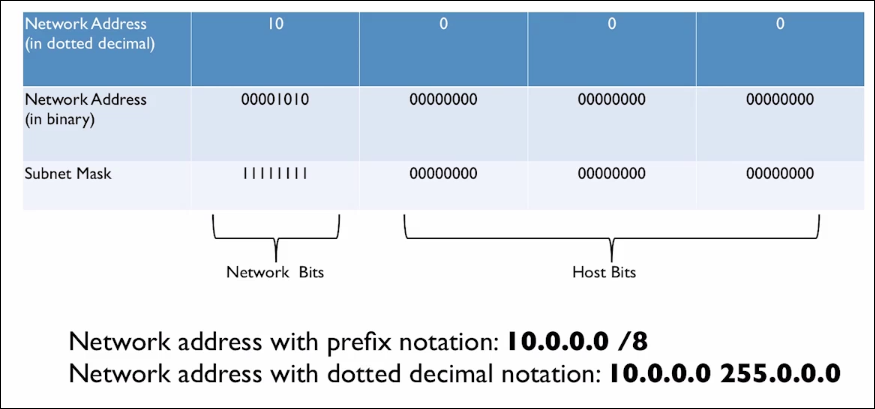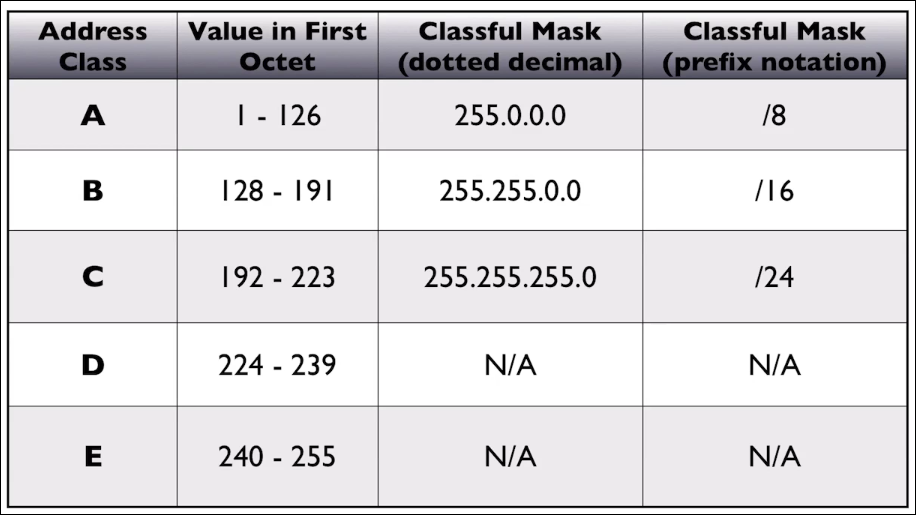Lesson 7 I Pv 4 Addressing
IPv4 addresses are made of 32 bits, separated in four sets of eight bits (called octets)
IPv4 address formatting:

Address classes:

- Overall 5 classes
- Three classes assigned to hosts - A, B, C
- D class - for multicast
- 127 - loopback address
- Publicly routable IP addresses are managed by ICANN (Internet Corporation for Signed Names and Numbers)
InterNIC (Internet Network Information Center) - predecessor of ICANN
ARIN (American Registry for Internet Numbers)
IANA (Internet Assigned Numbers Authority)
Private vs Public addresses:
- NAT (Network Address Translation) - translates between public and private IP addresses
- Private addresses- not routable on the Internet
10.0.0.0 - 10.255.255.255 /24
172.16.0.0 - 172.31.255.255 /16
169.254.0.0 - 169.254.255.255 /16
- not routable even inside organization
- self-assigned address (not coming from DHCP)
- used for APIPA (Automatic Private IP Addressing)
192.168.0.0 - 192.168.255.255 /24
Unicast:
- a "one-to-one" communication on the network
- not useful for sending multiple copies of a file to many machines
Broadcast:
- a "one-to-all" communication flow
- from one device in a subnet to all devices in the same subnet
Multicast:
- a "one-to-many" communication flow
- from one device in a subnet to many (not all) devices in the same subnet
- Class D address
Calculating Available Subnets:
- Number of Created Subnets = 2s where s is the number of borrowed bits (the number of bits added to a classful subnet mask)
ex.: 192.168.1.0 - class C - natural mask is /24
23 = 8
Calculating Available Hosts:
- Number of Assignable IP Addresses in a Subnet = 2h -2, where h is the number of host buts in the subnet
host bits all set to 0 --> Network Address
host bits all set to 1 --> Directed Broadcast Address
Calculating Usable Ranges of IPv4 Addresses:
- 172.25.0.0/24
What is the last octet to contain a 1 in the subnet mask? -> 11111111.11111111.11111111.00000000
What is the block size that we count by the interesting octet?
- block size = 256 - Value in the subnet mask's interesting octet
- subnet mask = 255.255.255.0
- value in the subnet mask's interesting octet = 255
- block size = 256 -255 = 1 1
- We count by 1 in the third octet to calculate the subnets:
172.25.0.0/24 172.25.1.0/24 172.25.2.0/24 … 172.25.255.0/24
What are the usable ranges of IP addresses in each subnet?
Classless Inter-Domain Routing (CIDR)
- summarizes networks by removing subnet bits
- also known as suppernetting